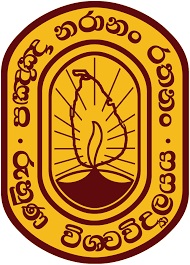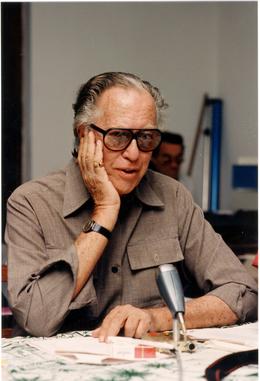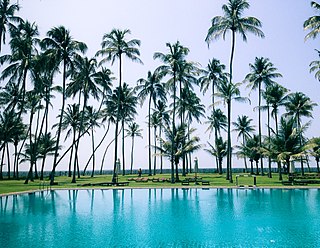
Modern architecture, or modernist architecture, was an architectural movement or architectural style based upon new and innovative technologies of construction, particularly the use of glass, steel, and reinforced concrete; the idea that form should follow function (functionalism); an embrace of minimalism; and a rejection of ornament. It emerged in the first half of the 20th century and became dominant after World War II until the 1980s, when it was gradually replaced as the principal style for institutional and corporate buildings by postmodern architecture. According to Le Corbusier the roots of the movement were to be found in the works of Eugène Viollet le duc.

Bishop's College in Colombo, Sri Lanka, is a private girls' school founded by the Anglican Church of Ceylon in February 1875.

Minnette de Silva was an internationally recognised architect, considered the pioneer of the modern architectural style in Sri Lanka. De Silva was a fellow of the Sri Lanka Institute of Architects.

The University of Ruhuna is a public university in Matara, Sri Lanka.

Deshamanya Geoffrey Manning Bawa, FRIBA was a Sri Lankan architect. He was among the most influential Asian architects of his generation.
Tangalle is a large town in Hambantota District, Southern Province, Sri Lanka, governed by an Urban Council. It is one of the largest towns in southern province. It is located 195 km (121 mi) south of Colombo and 35 km (22 mi) east of Matara. It has a mild climate, in comparison to the rest of the district, and sandy beaches.

The architecture of Sri Lanka displays a rich variety of architectural forms and styles. Shaivism has had a significant influence on early Sri Lankan architecture, during the reign of King Ravana, then Buddhism has also had a significant influence on Sri Lankan architecture, since it was introduced to the island in the 3rd century BCE.
The Sri Lankan Parliament Complex is a public building and landmark that houses the Parliament of Sri Lanka. Situated in Sri Jayawardenepura Kotte, the administrative capital, it is built on an island, surrounded by the Diyawanna Oya. It was designed by Deshamanya Geoffrey Bawa.

William Kerry Hill AO was a Singapore-based, Australian architect who specialised in hotel design in tropical Asia. His works were known for their features of steeply-pitched pavilion roofs, shaded walkways, and an abundance of water features, affectionately dubbed the "Kerry Hill touch".

Justin Samarasekera was a Sri Lankan architect. He is considered to be one of the founding fathers of the architectural profession in Sri Lanka and a pioneer of architectural education in the country.
James John Ulrik Plesner was a Danish architect who has mainly worked abroad, most notably in Sri Lanka and Israel.

Major Bevis William Frederick Bawa, ADC, CLI was a Ceylonese planter, soldier and a landscaper. He was also one of the most renowned landscape architects in Sri Lanka and served as the Aide-de-camp to four Governors of Ceylon.
Raj Barr-Kumar FAIA FRIBA, also known as Raj Barr, is an American architect, professor of architecture and was the 1997 national president of the American Institute of Architects.

Seema Malaka is a Buddhist temple in Colombo, Sri Lanka. The temple is mainly used for meditation and rest, rather than for worship. Situated in the Beira Lake, the temple was originally constructed in the late 19th century. Seema Malaka is a part of the Gangaramaya Temple and is situated few hundred meters to its east.

Blue Water Hotel is a 5-star boutique hotel in Wadduwa, Sri Lanka. It is notable for being Geoffrey Bawa’s last hotel project and the last project he supervised on site before succumbing to illness.
Oruwala, also spelled Oruwela, was a village but is now a suburb of Colombo in the Colombo District, Western Province, Sri Lanka.
Kala Suri Barbara Sansoni was a Sri Lankan designer, artist, colourist, entrepreneur, and writer. She was known for her works in architecture, textile designs, and handwoven panels. She founded the Barefoot textile company, a company that is highly acclaimed for its handloom fabric. She also served as the chairperson and chief designer of Barefoot Pvt. Ltd for several years.
Panini Tennekoon was a renowned Sri Lankan architect. He spent most of his career as a public servant, working in the Public Works Department, serving as the country's chief architect, before running his own architectural practice, designing low-cost housing and investigating sustainable timber use in construction. He was a fellow of Sri Lankan Institute of Architects and the Royal Australian Institute of Architects.

Cinnamon Bentota Beach, formerly known as Bentota Beach Hotel, is a luxury five-star hotel in Bentota, Sri Lanka. The hotel was built in 1967 and designed by Geoffrey Bawa. After refurbishment, the hotel reopened in 2019. The hotel is owned and operated by a subsidiary of John Keells Holdings under its luxury hotel chain, Cinnamon Hotels & Resorts. Cinnamon Bentota Beach is known for its architecture and decor.











